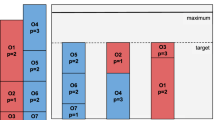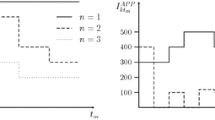Abstract
A multiple-objective hierarchical production planning and scheduling model is developed that integrates aggregate type decisions, family disaggregate decisions, lotsizing and scheduling of the jobs. It is assumed that demand and production failure are subject to uncertainties. Stochastic programming with recourse using a constraint sample approximation method is used to incorporate random demand and production failure into the model. The model evaluates final production plans, updates the demand forecasts and proceeds on a rolling horizon manner. Experimental results show that it is sufficient to generate and incorporate into the aggregate type model a small sample of the stochastic constraints from an infinite set of scenarios. A heuristic scheduling algorithm provides detailed information regarding the progress of jobs through work centers. This information is extremely useful in resolving infeasibilities during the production process. Other features of the model are also reported.
Similar content being viewed by others
Explore related subjects
Discover the latest articles and news from researchers in related subjects, suggested using machine learning.References
K.R. Baker, An experimental study of the effectiveness of rolling schedules in production planning, Dec. Sci. 8(1977)19–27.
D. Bienstock and J.F. Shapiro, Optimizing resource acquisition decisions by stochastic programming, Manag. Sci. 34(1988)215–229.
G.R. Bitran, E.A. Hans and A.C. Hax, Hierarchical production planning: A single stage system, Oper. Res. 29(1981)717–743.
G.R. Bitran, E.A. Haas and A.C. Hax, Hierarchical production planning: A two stage system, Oper. Res. 30(1982)232–251.
G.R. Bitran and A.C. Hax, On the design of hierarchical production planning systems, Dec. Sci. 8(1977)28–55.
G.R. Bitran and H.H. Yanasse, Deterministic approximation to stochastic production problems, Oper. Res. 32(1984)999–1018.
A.B. Borison, P.A. Morris and S.S. Oren, A state-of-the-world decomposition approach to dynamics and uncertainty in electric utility generation expansion planning, Oper. Res. 32(1984)1052–1068.
M.R. Bowers and J.P. Jarvis, A hierarchical production planning and scheduling model, Dec. Sci. 23(1992)144–159.
A. Chakranarty and G.E. Martin, Optimal multi-period inventory grouping for coordinated periodic replenishment under stochastic demand, Comp. Oper. Res. 15(1988)263–270.
J. Ershler, G. Fontan and C. Mercer, Consistency of the disaggregation process in hierarchical planning, Oper. Res. 34(1986)464–469.
B. Hansotia, Stochastic linear programming with recourse: A tutorial, Dec. Sci. 11(1980) 151–168.
A.C. Hax and J.J. Golovin, Hierarchical production planning systems, in:Studies in Operations Management, ed. A.C. Hax (North-Holland, Amsterdam, 1978).
A.C. Hax and H.C. Meal, Hierarchical integration of production planning and scheduling, in:Studies in Management Science, Logistics, ed. M.A. Geisler (North-Holland/American Elsevier, New York, 1975).
R. Jagannathan, Linear programming with stochastic processes as parameters as applied to production planning, Ann. Oper. Res. 30(1991)107–114.
U.S. Karamarkar, Equalization of run out times, Oper. Res. 29(1981)757–762.
A.M. Law and W.D. Kelton,Simulation Modeling and Analysis, 2nd ed. (McGraw-Hill, 1991) pp. 490–492.
G.K. Leong, M.D. Oliff and R.E. Markland, Improved hierarchical production planning, J. Oper. Manag. 8(1989)90–114.
J.J. Liberatore and T. Miller, A hierarchical production planning system, Interfaces 15(1985) 1–11.
M.Z. Meybodi, Aggregate production planning and scheduling with multiple criteria and stochastic production events, Ph.D. Dissertation, School of Industrial Engineering, University of Oklahoma (1990), unpublished.
E.M. Modiano, Derives demand and capacity planning under uncertainty, Oper. Res. 35(1987)185–197.
M.D. Oliff and E.E. Burch, Multiproduct production scheduling at Owen-Corning Fiberglass, Interfaces 15(1985)25–34.
J.A. Orlicly,Material Requirement Planning (McGraw-Hill, New York, 1975).
D.T. Phillips, A. Ravindran and J. Solberg,Operations Research: Principles and Practice (Wiley, 1976).
G.H. Saad, Hierarchical production planning systems: Extensions and modifications, J. Oper. Res. Soc. 41(1990)609–624.
L. Somlyody and R.J-B Wets, Stochastic optimization models for lake euthrophication management, Oper. Res. 25(1988)660–681.
B. Strazicky, Some results concerning an algorithm for the discrete recourse problem, in:Stochastic Programming, ed. M.A.H. Dempster (Academic Press, 1980).
U. Wemmerlov, The behavior of lot-sizing procedures in the presence of forecast errors, J. Oper. Manag. 9(1989)37–47.
Author information
Authors and Affiliations
Rights and permissions
About this article
Cite this article
Meybodi, M.Z., Foote, B.L. Hierarchical production planning and scheduling with random demand and production failure. Ann Oper Res 59, 259–280 (1995). https://doi.org/10.1007/BF02031750
Issue Date:
DOI: https://doi.org/10.1007/BF02031750




